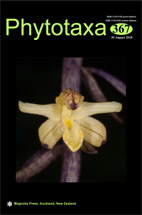Abstract
The genus Lophopogon Hackel (1887: 26) is endemic to India (Singh et al. 2015) and is represented by two species, viz. L. kingii Hook. f. (1896: 149) and L. tridentatus (Roxburgh) Hackel (1889: 254). The distribution of L. kingii is restricted to Bihar and Odisha (Chandramohan et al. 2016; Tiwari et al. 2017), whereas L. tridentatus is more widespread, distributed in Andhra Pradesh, Bihar, Gujarat, Karnataka, Madhya Pradesh, Maharashtra and Tamil Nadu. (Bor 1960; Singh & Deshpande 1980; Sur 2004; Kabeer et al. 2009). On critical study and survey of literature, it was found that the name L. tridentatus needs to be typified.
References
Chandramohan, K., Prasanna, P.V. & Reddy, R.P. (2016) Note on the distribution of Lophopogon kingii Hook. f. (Poaceae), an endemic grass from Eastern Ghats. International Journal of Advanced Research in Science and Technology 5 (2): 604–605.
Clarke, C.B. (1874) Preface to the reprint, 1874. In: Roxburgh, W. (Ed.) Flora Indica; or descriptions of Indian plants, Calcutta. pp. i-vi.
Hackel, E. (1887) Gramineae In: Engler, A. & Prantl, K. (Eds.) Die Naturlichen Pflanzenfamilien II. Verlag Von Wilhelm Engelmann, Leipzig. 1–97 pp.
Hackel, E. (1889) Monographiae Phanerogamarum Prodrominunc Continuato, Nunc Revisio. Aliisque Botanicus Ultra Memoratis, Paris. pp. 254–255.
Hooker, J.D. (1896) The Flora of British India, Vol. 7. L. Reeve & Co., London, 149 pp.
Kabeer, K.A.A. & Nair, V.J. (2009) Flora of Tamil Nadu—Grasses. Botanical Survey of India, Kolkata, pp. 450–451.
Linnaeus, C. (1753) Species plantarum, vol. 1. Salvius, Stockholm, Sweden, 560 pp.
Roxburgh, W. (1820) Flora Indica. The Mission Press, Serampore, 261 pp.
Royal Botanic Gardens Kew (2006) Roxburgh’s Flora Indica. Published on the Internet. Available from: http://www.kew.org/floraIndica/ (accessed 9 July 2018)
Singh, N.P. & Deshpande, U.R. (1980) A Critical note on the genus Lophopogon Hack. in India. Annals of Arid Zone 19: 168–170.
Singh, P., Karthigeyan, K., Lakshminarasimhan, P. & Dash, S.S. (2015) Endemic Vascular Plants of India, Botanical Survey of India, Kolkata, 304 pp.
Sprengel, C.P.J. (1825) Systema vegetabilium, 1. Editio decima sexta. Gottingae, p. 283.
Sur, P.R. (2004) A taxonomic revision of the genus Lophopogon Hack. (Poaceae) in India. Journal of Economic and Taxonomic Botany 28: 545–548.
Tiwari, A.P., Gavade, S. & Mujaffar, S. (2017) Lectotypification of Lophopogon kingii (Poaceae, Andropogoneae). Phytotaxa 296 (3): 295–296.
https://doi.org/10.11646/phytotaxa.296.3.10
Turland, N.J., Wiersema, J.H., Barrie, F.R., Greuter, W., Hawksworth, D.L., Herendeen, P.S., Knapp, S., Kusber, W.-H., Li, D.-Z., Marhold, K., May, T.W., McNeill, J., Monro, A.M., Prado, J., Price, M.J. & Smith, G.F. (2018) International Code of Nomenclature for algae, fungi, and plants (Shenzhen Code) adopted by the Nineteenth International Botanical Congress Shenzhen, China, July 2017. [Regnum Vegetabile 159]. Koeltz Botanical Books, Glashütten.
https://doi.org/10.12705/Code.2018

